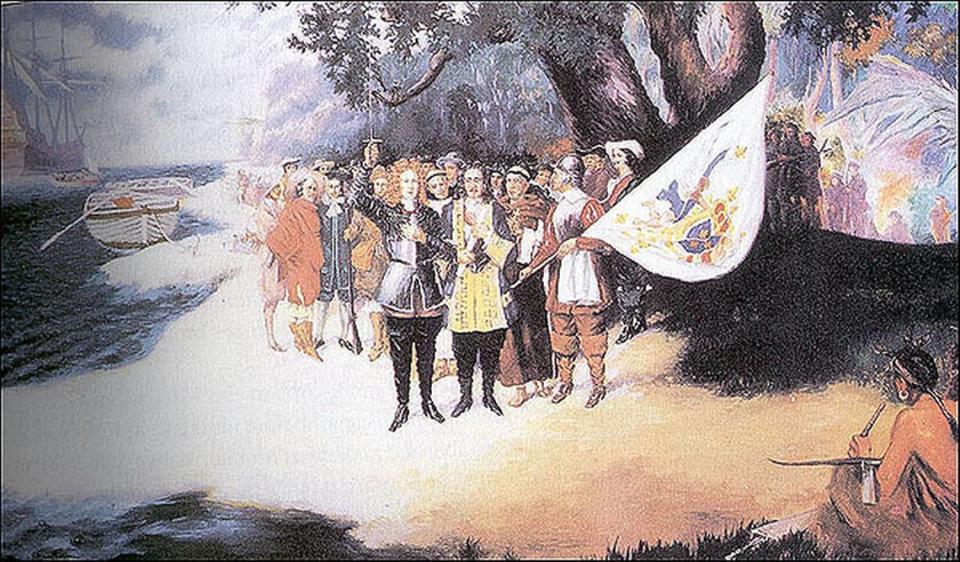Biloxi was named and Ship Island was discovered during this key period in MS Coast history
- Oops!Something went wrong.Please try again later.
Some of the most important facets of Mississippi Coast culture begin at a time in history that’s relatively unknown by locals.
Biloxi would not have gotten its name and Ship Island could not have been used as a safe place in the Underground Railroad had it not been for the colonial era.
The state’s colonial history begins with the arrival of European explorers in the 16th century. However, it was the French who would establish the first lasting colonial presence, staking their claim on the captivating Gulf Coast.
For thousands of years before Europeans arrived, Mississippi’s land was inhabited by Native American groups of the Mississippian culture. Then, in the early 1500s, the renowned Spanish conquistador and explorer, Hernando de Soto, made landfall in Florida. He began carving out a Spanish Empire in the New World, first by exploring the vast American Southeast.
De Soto’s expedition became the first recorded Europeans to set foot in Mississippi and engage with its indigenous inhabitants. De Soto would meet his demise on the banks of the Mississippi River, being remembered as the first European to discover it. However, his presence, through conflict and the spreading of diseases, devastated most of the Native population in the region.
Following De Soto’s expedition, France laid claim to the Mississippi region during the height of colonialism. King Louis XIV dispatched an expedition led by Pierre Le Moyne D’Iberville to seek out the mouth of the Mississippi River. Securing this would link France’s colonies in the North with their colonies in the Caribbean.
Discovering Ship Island
Setting sail from La Rochelle on October 24, 1698, D’Iberville, accompanied by his younger brother Jean-Baptiste de Bienville and a group of 200 Canadian laborers and soldiers, embarked on a daring journey. Their naval squadron, comprising frigates Le Badine and Le Marin, along with two supply ships, was joined by another vessel, Le Francois, upon reaching the Caribbean.
Venturing north, the expedition made stops in Spanish Florida and Mobile Bay before landing on one of the channel islands just south of Mississippi on February 10, 1699. This island, with its natural deepwater harbor, was promptly named Ile aux Vaisseaux, or Ship Island.
With Ship Island serving as their operational base, D’Iberville and his men set foot on the mainland on February 13, 1699. They quickly established friendly relations with the local Biloxi Native American tribe and embarked on an exploration of the Mississippi Coast.
Over the course of the following months, D’Iberville and his men journeyed westward, venturing as far as the present-day site of Baton Rouge. Yet, despite their efforts, they failed to find a suitable location for a permanent settlement. As provisions began to dwindle in April, D’Iberville made the decision to construct Fort Maurepas, which stands in present-day Ocean Springs.
The region was named Biloxi after the local Native tribe, becoming the first capital of French Louisiana. Leaving behind his brother and a contingent of fewer than 100 men, D’Iberville returned to France on May 3 to report his discoveries to the king. Meanwhile, Bienville and a group of remaining explorers continued their coastal exploration throughout the summer, ultimately discovering a bay to the west teeming with wildlife. They named it the Bay of St. Louis.
In December of that same year, D’Iberville returned to the Mississippi Coast, bringing with him food and reinforcements numbering about 60. During his absence, Bienville had established a settlement on the western coast of the bay, which they named Baye de Saint Louis. D’Iberville, on the other hand, founded Fort Mississippi 50 miles up the Mississippi River while continuing his exploration. This linked France’s Gulf Coast colony with a route to colonies in the Midwest and Canada.
D’Iberville would depart the coast once again in May 1700, but by then, the French colony on the Mississippi coast had firmly taken root. Upon his second return in December 1700, he orchestrated the transfer of the colony’s capital, along with a significant portion of its residents, from Biloxi to Mobile Bay.
New Orleans takes over as French capital
April 1702 marked D’Iberville’s final departure from the colony, as he tragically passed away in Havana, Cuba, in 1706. Bienville maintained his capital in Mobile Bay until a hurricane in 1717 altered the region by blocking much of the bay with sand. In response, he reestablished Ship Island as the primary port while constructing a new settlement west of Fort Maurepas, known as Nouveau-Biloxi, or Fort Louis.
New Biloxi would remain the capital of French Louisiana until 1722, when New Orleans took its place. Boasting a superior deepwater harbor and greater protection against hurricanes, New Orleans became the new center of power for Bienville and the French.
Consequently, the Mississippi Coast saw limited further development under French rule. While Biloxi and other settlements in the area managed to survive, only a handful of settlers remained. Following France’s defeat in the Seven Years’ War, the region east of the Mississippi River was ceded to the British in 1763.
However, the Spanish would conquer the Gulf Coast during the American Revolution, creating the territory of West Florida. The United States eventually acquired this territory, including the whole southern half of the state, in 1810 and incorporated it into the Union in 1817, marking the end of Mississippi’s colonial era.


